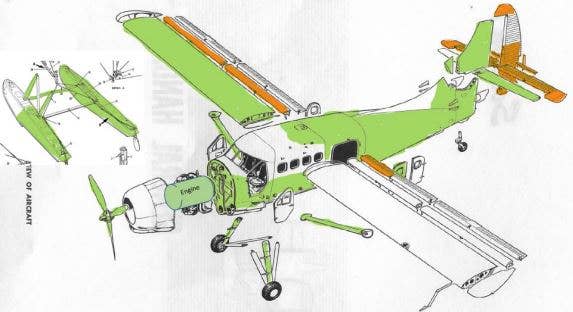NTSB Probe Into Downed DHC-3 Seaplane Focuses on Tail
In a new report, the National Transportation Safety Board said it is focusing on a broken part as a potential cause of the September Otter accident that killed 10 people.

The National Transportation Safety Board (NTSB) released a report Monday that says a broken actuator on the horizontal stabilizer could potentially be the cause of the aircraft’s fatal plunge into the Puget Sound. [Image courtesy: NTSB]
The investigation into the crash of a seaplane north of Seattle last month that killed 10 people is focusing on the tail of the de Havilland Canada DHC-3 Otter turboprop. The National Transportation Safety Board (NTSB) released a report Monday that says a broken actuator on the horizontal stabilizer could potentially be the cause of the aircraft's fatal plunge into the Puget Sound.
The actuator is part of the aircraft's pitch control. If the actuator is compromised, the aircraft can enter an uncommanded climb or descent from which the pilot cannot recover.
The 10-page report notes that when approximately 85 percent of the wreckage was retrieved from the ocean floor, the upper portion of the broken actuator was found still attached to the horizontal stabilizer, while the lower portion was attached to its mount in the fuselage.
The separation of the actuator happened when a clamp nut that threads into a barrel section had unthreaded.
The report reads: "Examination of the threads inside the barrel and the threads on the clamp nut revealed that the two components separated by unthreading (that is, rotation of the barrel and/or clamp nut) as opposed to being pulled apart in tension. The upper portion of the actuator remained attached to the horizontal stabilizer, and the lower portion remained attached to its mount in the fuselage."
A lock ring is supposed to prevent unthreading. The lock ring was not located in the wreckage, however, it was observed that three of five holes drilled in the clamp nut to accept the lock ring were damaged in such a way that they would not allow for full insertion of the lock ring.
"Further, it might be difficult to visually determine if the lock ring is fully engaged in the clamp nut hole depending on conditions such as lighting, viewing angle, and the presence of dirt or grease," the report said.
According to preliminary information from the operator, the most recent overhaul of the horizontal stabilizer actuator was completed on April 21, 2022.
The NTSB notes the actuator is the only means to hold the horizontal stabilizer in its position, and the lock ring keeps the assembly from unthreading. Unthreading of the clamp nut and the barrel during flight would result in a free-floating horizontal stabilizer, allowing it to rotate uncontrollably (trailing edge up or down) about its hinge, resulting in a possible loss of airplane control.
The report concludes that the NTSB has not determined if the lock ring was installed before the airplane impacted the water or why the lock ring was not present during the airplane examination.
The NTSB is working with the Transportation Safety Board of Canada to ask the manufacturer to draft instructions for an inspection of the actuator to ensure that the lock ring is in place and properly engaged to prevent unthreading of the clamp nut.
"Those instructions will be released and provided to all operators of the DHC-3 airplane worldwide in a Service Letter," the NTSB said.
The aircraft was registered to Northwest Seaplanes, a Part 135 operation. The aircraft was on a flight between Friday Harbor Seaplane Base (W33) and Renton Municipal Airport (KRNT) at the time of the accident. It was the pilot’s second flight of the day.
There was no report of a distress call from the pilot before the aircraft went down in Mutiny Bay off Whidbey Island in Washington. According to witnesses, the aircraft was flying at an altitude of approximately 600 feet above the surface when it suddenly plunged into the water, killing all 10 people on board.
It took more than a week to find the wreckage under the water. Only six of the bodies have been recovered.
Approximately two weeks ago, the FAA released the emergency AD focusing on the tail assemblies of DHC-3. Transport Canada issued a similar AD more than four years ago in response to corrosion found on DHC-3 tail assemblies. The AD established a requirement for inspecting the aircraft’s elevators for corrosion, which can lead to structural failure and result in an uncommanded nose-down pitch moment.

Sign-up for newsletters & special offers!
Get the latest FLYING stories & special offers delivered directly to your inbox






